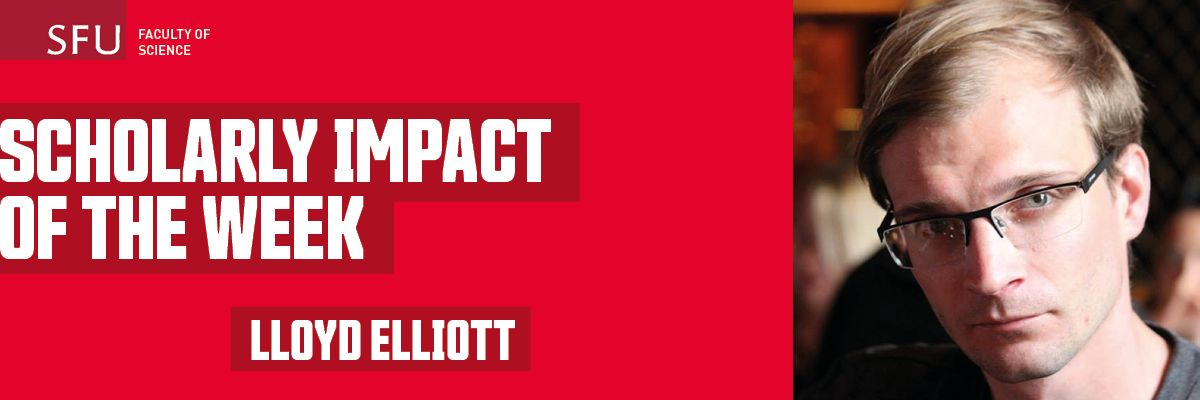 by Heather Sanders
by Heather Sanders
The UK Biobank is an extensive biomedical database containing in-depth genetic and health information from half a million volunteers, and is regularly updated with new data. In the spirit of collaboration and to advance modern medicine, the Biobank had been made accessible to approved researchers from around the globe. This data-sharing has enabled thousands of scientists worldwide to gather insights into the biomarkers of diseases and aging. Referred to as genome-wide association studies (GWAS), the scientific community is collaborating to discover associations between DNA variants and human diseases.
SFU statistics and actuarial sciences professor Lloyd Elliott, Stephen Smith from the University of Oxford, their students and colleagues have been working with the Biobank data for the past several years. They published their first study in 2018 using brain imaging data from around 8,500 individuals and identified 17 different genes involved in brain development, neuropathways and neuroplasticity. They’ve recently completed a follow-up study, An expanded set of genome-wide association studies of brain imaging phenotypes in UK Biobank, using newly released data and increasing their discovery sample size.
Elliott and Smith’s research was carried out in partnership with the Wellcome Centre for Integrative Neuroimaging (WIN), at the John Radcliffe Hospital in Oxford, and SFU. SFU Masters’ student Winfield Chen helped with coding and data manipulation of thousands of three-dimensional images.
The Biobank now has brain imaging from over 40,000 subjects. An epidemiological and longitudinal study, it follows individual health outcomes, lifestyle, biophysical measures and genetics over decades. Participants were recruited between the ages of 40 and 69, meaning they were at risk of developing age-related illnesses, which makes the Biobank a major resource for understanding the role of the brain in human health and disease.
The data available to the researchers spans six magnetic resonance imaging (MRI) modalities, which allows them to study many different aspects of brain structure, function and connectivity. The images are three-dimensional, yielding millions of voxels – the 3D equivalent to a pixel. And, the current data almost triples the size of the 2018 study.
These data were processed to generate a list of thousands of image-derived phenotypes (IDPs) – traits related to brain structure or function that can be identified through images. Elliott and colleagues investigated the associations between these IDPs and their genetic variants.
“Our goal is to draft a three-dimensional map of human genetic variations and variations in the human brain as they are associated with diseases,” says Dr. Elliott. “We are not studying a specific disease or chromosome, but looking at all the data we have to assess the associations with disease. Now that we have more data, we can make stronger connections.”
Elliott explains that using the DNA information or genotypes provide by subjects, they can correlate these with variations in the brain – or phenotypes. Genotypes are at the micro level – in the chromosomes, and phenotypes are at the macro level, manifesting as conditions that can be seen. The human genome is three billion base pairs long and the brain has thousands of identified phenotypes so the amount of data to review is incredibly vast.
In the recent study, the researchers were able to identify links between the observed phenotypes and respective genes that influence iron transport and storage, brain development, pathway signaling and plasticity. An association was made between genetic variants and levels of Insulin-like growth factor 1, which has emerged as a risk factor for dementia and Alzheimer’s disease due to its role in removing disease-associated amyloid-beta peptides from the brain. Other associations were made between genes and cardiovascular issues including atrial fibrillation, congestive heart failure, hypertension, stroke and premature coronary heart disease.
They also found associations involved in the recently identified STAR condition (syndactyly, telecanthus and anogenital and renal malformations), Waisman syndrome, early-onset Parkinson’s disease, X-linked autism, and Huntington’s disease.
For the first time, there was enough data available in the Biobank to conduct two additional genome-wide association studies that restricted the discovery cohort to just genetic females and (separately) just genetic males. This enabled the researchers to explore genetic associations on the X chromosome. The findings demonstrate that there is greater statistical sensitivity when carrying out sex-specific GWAS on the X chromosome, and then combining the results with a meta-analysis, than by combining all subjects together in a simple standard GWAS.
As Smith and Elliott are researching they are also sharing their findings in searchable online resources and have uploaded terabytes of data including their three-dimensional map of the brain with the thousands of corresponding genotypes (DNA) and phenotypes (brain characteristics). They’ve also provided an open source version of their research methods, algorithms, and results. It’s all part of the larger worldwide effort to map human genetics and disease susceptibility using an unprecedented amount of data, international collaboration and cooperation from UK Biobank participants.
“The brain is quite a difficult and complex area of study, so the more we know at the genetic level, the better it is for our understanding of brain health and disease. I encourage researchers to use our data to look for other findings,” says Dr. Elliott. “I’m grateful for the partnerships thus far, and especially proud of the students who have helped with this research. I look forward to adding more collaboration on this side of the ocean.”
This work was carried out in partnership with The Wellcome Centre for Integrative Neuroimaging (WIN), and funding from the Natural Sciences and Engineering Research Council of Canada
SFU's Scholarly Impact of the Week series does not reflect the opinions or viewpoints of the university, but those of the scholars. The timing of articles in the series is chosen weeks or months in advance, based on a published set of criteria. Any correspondence with university or world events at the time of publication is purely coincidental.
For more information, please see SFU's Code of Faculty Ethics and Responsibilities and the statement on academic freedom.